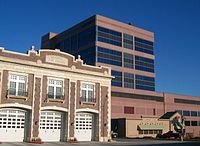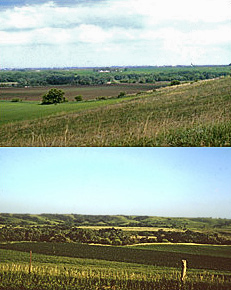
South Dakota is a U.S. state in the North Central region of the United States. It is also part of the Great Plains. South Dakota is named after the Dakota Sioux Native American tribe, which comprises a large portion of the population with nine reservations currently in the state and has historically dominated the territory. South Dakota is the 17th largest by area, but the 5th least populous, and the 5th least densely populated of the 50 United States. As the southern part of the former Dakota Territory, South Dakota became a state on November 2, 1889, simultaneously with North Dakota. They are the 39th and 40th states admitted to the union; President Benjamin Harrison shuffled the statehood papers before signing them so that no one could tell which became a state first. Pierre is the state capital, and Sioux Falls, with a population of about 192,200, is South Dakota's most populous city.

Sioux Falls is the most populous city in the U.S. state of South Dakota and the 121st-most populous city in the United States. It is the county seat of Minnehaha County and also extends into northern Lincoln County to the south, which continues up to the Iowa state line. As of 2022, Sioux Falls had an estimated population of 202,078. The Sioux Falls metro area accounts for more than 30% of the state's population. Chartered in 1856 on the banks of the Big Sioux River, the city is situated in the rolling hills at the junction of interstates 29 and 90.
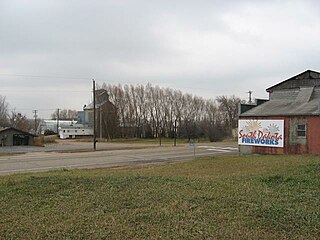
Rowena is an unincorporated community and a census-designated place (CDP) in Minnehaha County, South Dakota, United States. The population of the CDP was 68 at the 2020 census. It is located along South Dakota Highway 42.

South Dakota Public Broadcasting (SDPB) is a state network of non-commercial educational television and radio stations serving the U.S. state of South Dakota. The stations are operated by the South Dakota Bureau of Information and Telecommunication, an agency of the state government which holds the licenses for all of the PBS and NPR member stations licensed in South Dakota except KRSD in Sioux Falls, which is owned and run by Minnesota Public Radio, and KAUR in Sioux Falls, which is owned by Augustana University and operated by MPR. SDPB's studios and offices are located in the Al Neuharth Media Center on the campus of the University of South Dakota in Vermillion.
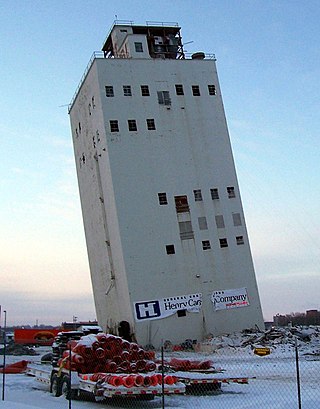
The Zip Feed Tower was a grain elevator and feed mill in Sioux Falls, South Dakota. At 202 feet it was the tallest occupiable structure in South Dakota from its construction in 1956–57 until its demolition in December 2005. The mill closed in 2000 and in 2005 was scheduled for demolition to make way for office and retail space.

The history of South Dakota describes the history of the U.S. state of South Dakota over the course of several millennia, from its first inhabitants to the recent issues facing the state.
Phoenix Plaza is a mixed use office complex located in midtown Phoenix, Arizona. It was built between 1988 and 1990 at a cost of US$158 million. There is 1,600,000 square feet (150,000 m2) of office space plus 225 hotel rooms. Phoenix Plaza has three hi-rise office buildings, a large parking garage and a hotel tower. Two distinct design concepts can be seen. The façades of CenturyLink Tower, the parking structure and Hilton Suites are colored in the late 1980s design trend of combining the pastel hues of “dusty rose” with turquoise. Phoenix Plaza Towers One and Two are sleek, modern, highly polished and complement the desert inspired buildings, which share their site. The architect for the buildings was Langdon Wilson and Phoenix Plaza was developed by the Koll Company and BetaWest Properties, Inc.
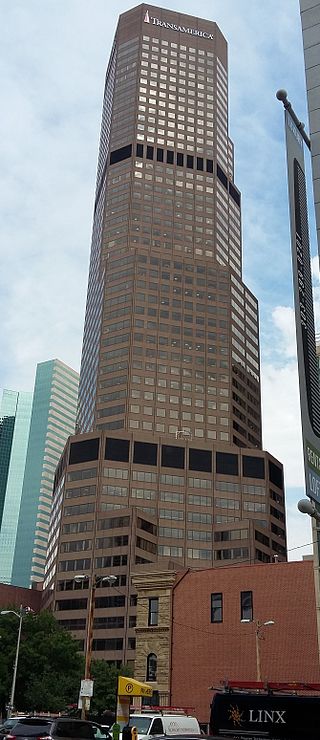
1801 California Street is a skyscraper in Denver, Colorado. The building was completed in 1983, and rises 53 floors and 709 feet (216 m) in height. The building stands as the second-tallest building in Denver and Colorado, and as the 151st-tallest building in the United States.

555 17th Street, formerly known as the Anaconda Tower and the Qwest Tower, is a skyscraper in Denver, Colorado. The building was completed in 1978, and rises 40 floors and 507 feet (155 m) in height. The building stands as the seventh-tallest building in Denver and Colorado. It also stood as the tallest building in the city at the time of its 1978 completion, and held that distinction for three years until it was surpassed by the 522-foot (159 m) 707 17th Street in 1981.
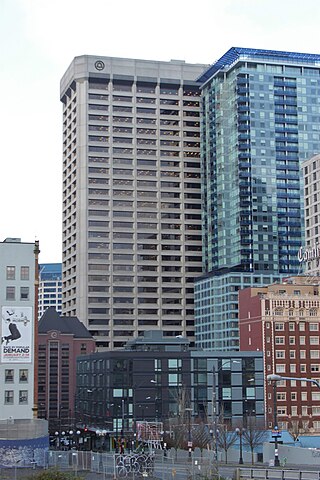
1600 Seventh is a 32-story, 498 ft (152 m) skyscraper in Seattle, Washington, United States. Designed by John Graham & Company, it was completed in 1976; as of 2022, it is the 22nd-tallest building in the city. Originally built as the headquarters of Pacific Northwest Bell, it was first known as the Pacific Northwest Bell Building during construction and subsequently as 1600 Bell Plaza upon opening; it was later known as Bell Plaza and Qwest Plaza under US West and Qwest ownership.

Kodak Tower is a 19-story skyscraper in the High Falls District of Rochester, New York, and is part of the Eastman Kodak Headquarters complex. It has a roof height of 340 ft (103.6 m) and stands 366 ft (111.6 m) with its antenna spire included. It was Rochester's tallest building for over 50 years from its completion in 1914 until the Xerox Square Tower surpassed it in the late 1960s. Today, it is the 4th tallest building in Rochester and is the 9th tallest building in New York state outside New York City.
This article describes transportation in the U.S. state of South Dakota.

The Federal Building and U.S. Courthouse, also known as U.S. Courthouse, Sioux Falls, is a historic federal office and courthouse building located at Sioux Falls in Minnehaha County, South Dakota. The building is still in use as a federal courthouse, being the seat of the United States District Court for the District of South Dakota. The structure is listed on the National Register of Historic Places.
The following is a timeline of the history of the city of Sioux Falls, South Dakota, USA.
Sioux Falls Pride, formerly The Center for Equality (CFE), is a non-profit organization in Sioux Falls, South Dakota, that supports and celebrates the LGBT community in South Dakota and provides resources for LGBT people and their allies. Completely volunteer-based, the Sioux Falls Pride Board of Directors and Committee work together to hosts the annual Pride event each June along with other events supporting the local LGBT community.

The flag of Sioux Falls, South Dakota, consists of a zigzag pattern of thin white and blue lines, which divides an upper blue portion and a lower pinkish-red portion, and a yellow sun in the upper left corner. The zigzag represents the namesake falls of the Big Sioux River. The blue color and the sun allude to the flag of South Dakota. The pinkish-red portion represents the Sioux Quartzite nearby. The upward direction of the design represents the growth of Sioux Falls. The red, white and blue colors included in the flag are also a reference to the flag of the United States while maintaining city and state pride.

The Hotel on Phillips is a hotel at 100 N. Phillips Ave. in Sioux Falls, South Dakota. It is located in the former Sioux Falls National Bank building, a skyscraper built in 1917, during World War I. The building was listed on the National Register of Historic Places in 1979 as "Sioux Falls National Bank Building". The property has also been known as the 100 North Phillips Building.
